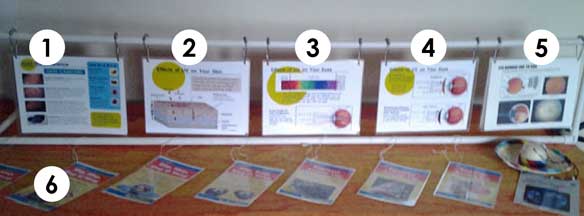
Health Effects of Solar Radiation
We believe it is also important to educate visitors about the harmful effects of the sun. The "UV Light detectors" help children become aware of when they are being exposed to ultraviolet light. The sunwise Q & A cards have been adapted from the EPA SunWise®program. For best results print cards on photo paper and laminate. We hole punch them, add a string and thread along the bottom of our frame.
See also: Electromagnetic Spectrum
- Spot the difference- Skin Cancer pdf | [adapted from Cancer Council, Victoria]
- Effects of UV on Your Skin pdf | Spanish pdf*
- Effects of UV on Your Eyes pdf | Spanish pdf* [eye graphic adapted from All Things Aviation]
- Effects of UV on Your Eyes pt 2 pdf | Spanish pdf*
- Eye Damage Due to Sun pdf | Spanish pdf*
- SunWise Q & A cards: *Spanish translation by Marcy Malavasi & Abi Malavassi, Costa Rico
- Slip pdf | Spanish pdf*
- Slop pdf | Spanish pdf*
- Slap pdf | Spanish pdf*
- Wrap pdf | Spanish pdf*
- Shade pdf | Spanish pdf*
- UV Index pdf
- Sunscreen pdf | FREE Sun Safety resources from EPA
- Are You at Risk? pdf | Spanish pdf
STEM Activity 1: UV Light Detectors

Purpose: Children use UV color changing beads to observe the effect of UV on their skin. This craft activity should be done inside or under a canopy if possible, away from direct sunlight.
Supplies needed per child: UV color changing beads, chenille stems (any color), snack size plastic bags.
Age level: easy enough for preschoolers. They are always so surprised when the white beads change color. Older children can use the beads to test the effectiveness of various sunscreens and/or sun glasses to block UV radiation.
Notes: Each student receives 5 different colored beads. I use a snack size plastic bag to prepackage one set of beads/child. This avoids children grabbing handfuls of beads and assures that each child receives a complete set. The beads are threaded onto chenille stems (pipe cleaners). We provide the lens and sunscreen. Beads can be purchased online:
Additonal Resources:
- UV Light Detecting Beads -Explanation of UV and lesson ideas from Educational Innovations.
- UV bead experiment worksheet
- Exploring Ultraviolet (UV) light from the Sun-lesson
- Stanford Solar Center: What is Ultraviolet Light?
STEM Activity 9: Sun Prints

Purpose: Children explore light and heat as different components of the Sun’s energy.
Supplies needed per child: 1 sheet of photosensitive paper person, objects (such as sticks, flowers, old keys, felt shapes,etc.), several clear acrylic sheets, a tub(s) of water, paper towels, access to a sunny location outside Age level: works best for elementary ages and up, but preschoolers do have a good time with it. Notes: Depending on your location, leave the prints in the sun until they turn a light blue. The prints will work on a cloudy day but will need more time to "print."Additonal Resources:
- Lunar and Planetary Institute: Amazing Rays Lesson
- Step-by-Step directions
- Sun Prints: Camerless Photographs
